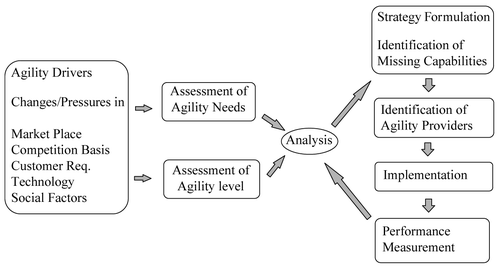-
- Home
- About us
- Our research
- Agility and manufacturing strategies
- Low-carbon and sustainable manufacturing
- Supply chain design, optimisation and management
- Complex system modelling, simulation and optimisation
- Staff and alumni
- News and events
- Contact us

Could have a picture here
Our research covers a broad range of issues associated with supply chain, which currently focuses on the following sub-areas:
Supply Chain Optimisation
We pioneered the application of agent based technology in modelling, simulating and optimising the configuration of global supply chain networks, and the use of Ant Colony Optimisation in multi-objective supply chain design.
Current work is focused on optimising the design of supply chain networks such that they can be cost-effective, reliable, adaptive and robust when dealing with risks and uncertainties. We are also working on multi-objective optimisation of supply chain operations in particular sourcing and inventory decisions to reduce cost, carbon emissions and delivery time.
Operations and supply chain management
Over the last ten years, supply chain management has become a key factor in manufacturing business successes and competitive advantage. Our research focuses on the relationships between suppliers and customers, the coordination of these relationships, and the resulting effects on total supply chain cost, quality and delivery. We are also investigating how supply chain management practices can be integrated towards the achievement of business or supply chain based strategies, such as lean and agility. A recent work investigates the coordination of project-based supply chains with dynamically changing project portfolios.
Sourcing, multi-level inventory and coordination in supply chains
Our research explores modelling sourcing and inventory decisions in a multi-tier supply chain and the coordination and optimisations of such decisions across supply chain members. We are also interested in decisions in remanufacturing systems involving closed-loop supply chains and reverse logistics. Operational research methods, meta-heuristics, and multi-objective optimisation are all investigated for solving these problems.
Project supply chains and dynamic portfolio management
Project oriented business operations need to manage a dynamically changing resource base across a supply chain to deliver a continuously changing project portfolio. Our research focuses on how to dynamically reschedule and reconfigure resources across the projects and supply chain to cope with changing situations. We investigate how to optimise resource and cost planning in new project bidding and how to make long term resource planning, based on shifts in market demand, to adapt to changing needs for resources, supply chain structures and skill sets.
Projects
- meCagrO2 - Safe products, sustainable Processes and employment increased attractiveness for companies from the 2 Seas agro-food area (Funded by the EU, University of Exeter, ICAM, ISA, KAHO Sint-Lieven (€3,980,280))
Abstract: The objective of the meCagr02 Project is to bring together all the academic partners in the EU 2 seas area who are presently involved in the various phases of the food process-product chain. The project contributes to the improvement of food processing industries – specifically agriculture and fishing products - developing alternative solutions dealing with sustainable products, processes and employment. The project is based on the needs reported by three big industrial groups from the area who have already expressed their interest in this project; it also strives to take into consideration the needs of other companies in the sector, especially SMEs. - Modelling and optimisation of inventory and sourcing decisions in a multiple-tier supply chain for low-carbon operation (Funded by Thailand Government)
Abstract: Manufacturing cost has become critical in the success of global supply chain networks, and a key topic in supply chain management has been the management of inventory cost and cost from wasted energy and resources. The waste issue has become even more important as the issues of climate change, energy security, food security and sustainability assume prominence in recent years. This situation is typified by an agriculture and food supply chain, where a lot of energy is consumed by the needs to maintain materials and products within controlled temperature during manufacturing, storage and transport and a lot of wastes are generated by materials and food wastage before reaching consumer due to their perishable nature. This work investigates how to optimising inventory and multiple sourcing decisions in a multi-tier supply chain, in particular a food chain, to minimise total cost and total carbon footprint whist maintaining delivery reliability and goods availability - Inventory control in a whole green manufacturing supply chain network with multiple sources and products (Funded by Indonesia Government)
Abstract: Inventory cost has become critical in the performance of companies operating in a supply chain and coordination among players is necessary in order to minimise inventory cost for the whole chain. This research aims to provide a methodology for managing production and inventory control integrally to minimise total supply chain’s inventory cost. It considers a supply chain with multiple sourcing decisions as well as reverse logistics for remanufacturing of end-of-life products. - Optimising supply chain management to cope with risks and uncertainties and maximise sustainability (Funded by University of Exeter and Chinese Scholarship Council)
Abstract: OEMs are often faced with the challenge of how to find the optimum supply chain structure that can meet customer orders at the minimum costs whilst having the robustness in coping with risks and uncertainties, being flexible to adapt to future changes in demand, and resulting in low carbon emissions. This research aims to define and solve a supply chain configuration problem that involves how manufacturing organisations would identify a supply chain structure that can cope with customer demand over a future period, with minimum cost, sufficient reliability, satisfactory quality, low carbon emission, and robustness in dealing with future risk and uncertainties, whist being able to adapt to future changes in demand and product mix.

